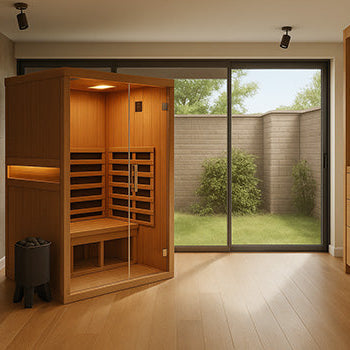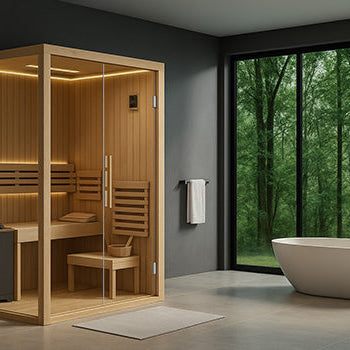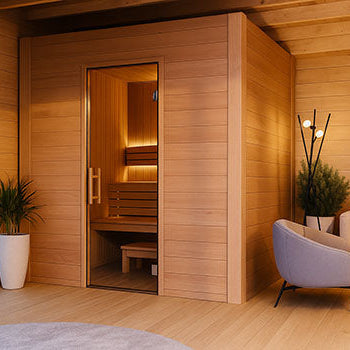Who invented saunas? No one—and everyone. There’s no single inventor behind that blissful heat you love. It’s the result of thousands of years of experimentation, sweat (literally), and shared wisdom.
From ancient sweat lodges to today’s sleek indoor sanctuaries and charming outdoor retreats, saunas have been reimagined across continents. The journey? Long, steamy, and absolutely fascinating.

The Invention of the Sauna: An Evolutionary Tale
Dispelling the Myth of a Single Inventor
Let’s clear one thing up—no brilliant mastermind dreamed up the sauna overnight. No ancient inventor was jotting down blueprints in a steam-filled hut.
Instead, cultures all over the world stumbled upon the same idea: heat feels good. People learned that hot stones, enclosed spaces, and a little steam could do wonders for the body.
The sauna wasn’t born—it evolved, shaped by climate, need, and community. It’s not a one-man invention. It’s a global collaboration through time.
Ancient Origins: Sweat Lodges and Early Heat Practices
Evidence of Early Heat Bathing Across Cultures
Dig through history, and you’ll find traces of sauna-like spaces everywhere. In Korea, people relaxed in stone hanjeungmak. In Turkey, there were steamy communal hammams. Across North America, Indigenous sweat lodges brought people together to heal and reflect.
And in prehistoric Finland? Simple earth pits lined with hot stones and covered with moss kept families warm through icy winters.
Heat bathing is as old as humanity—a shared solution to life’s cold, dirty, and exhausting moments.
The Purpose of Early Sweat Lodges (Cleansing, Warmth, Ritual)
These weren’t just hot rooms for washing off mud. Early sweat lodges were deeply symbolic.
They were where people cleansed their spirits, bonded with others, and faced the cold with courage. In Native American cultures, sweat lodges were sacred spaces for purification. In Mongolia, heat rooms helped families recover from illness and birth.
Even without electricity or spa menus, people knew one truth: sweating it out heals more than just the body.
The Evolution of the Sauna in Finland

From Earth Pits (Maasauna) to Smoke Saunas (Savusauna)
Finland didn’t just adopt saunas—it defined them.
The first versions were earth pits called maasaunas—practical, no-frills spaces dug into the ground. Later came the savusauna or smoke sauna, where wood fires heated piles of rocks for hours. Once the smoke was released, the heat lingered beautifully.
Imagine stepping into a room still warm from fire, the air scented with birch and smoke, and the whole family gathering inside to relax. That’s Finnish sauna culture in its rawest, most authentic form.
The Sauna's Deep Cultural Significance in Finland
In Finland, the sauna isn’t a luxury—it’s a lifestyle. Babies were born there. Elders passed on wisdom inside its walls.
It’s the cleanest room in the house and the most honest. People go in stressed and come out reborn. There’s no need for small talk, phones, or fancy gear. Just heat, quiet, and connection.
Even today, more than 3 million saunas exist in Finland—a country with only 5.5 million people. That’s more saunas than cars.
Development of Wood Stoves and Chimneys
By the early 20th century, smoke gave way to smarter systems. Wood-burning stoves with chimneys replaced the old smoke setups, making saunas safer and faster to heat.
Now, instead of waiting half a day to get things steamy, families could enjoy warmth on-demand. These updates helped bring saunas indoors—and into everyday life.
The sauna stepped out of the forest and into modern homes, without losing its rustic charm.
The Modern Sauna: Electric Heaters and Infrared Technology
Transition to More Convenient Heating Methods
Electricity changed the game.
Suddenly, you didn’t need to chop wood or tend a fire. Just flip a switch, and within minutes, you’re wrapped in heat. This convenience helped saunas become common in city apartments, gyms, and spas.
Then came infrared saunas, which use light to warm the body directly instead of heating the air. Drier, gentler, and great for those who want the benefits of heat without the intensity.
Technology made the sauna more accessible, without losing its soul.
The Spread of Sauna Culture Globally
From Tokyo wellness centres to London gardens, saunas are everywhere now. People enjoy them on rooftops, in hotel suites, and even in tiny barrel sauna setups at home.
Finnish sauna culture went global—but its essence remained.
Wherever you are, stepping into a sauna still feels like pressing pause on life. You sweat, you breathe, and for a few glorious minutes, nothing else matters.
Conclusion: An Ancient Practice Evolved Over Millennia

So, who invented saunas? No one. And everyone.
They were born out of cold winters, sore muscles, and a deep human need to feel warm, clean, and connected. From traditional outdoor saunas to modern indoor sanctuaries, the sauna’s journey is one of shared wisdom and evolution.
It’s not just a hot room—it’s a human tradition. Passed down, reimagined, and loved across continents and centuries.
And the best part? That story isn’t over. It continues every time someone steps into the steam and sighs, “Ahh, that’s better.”








